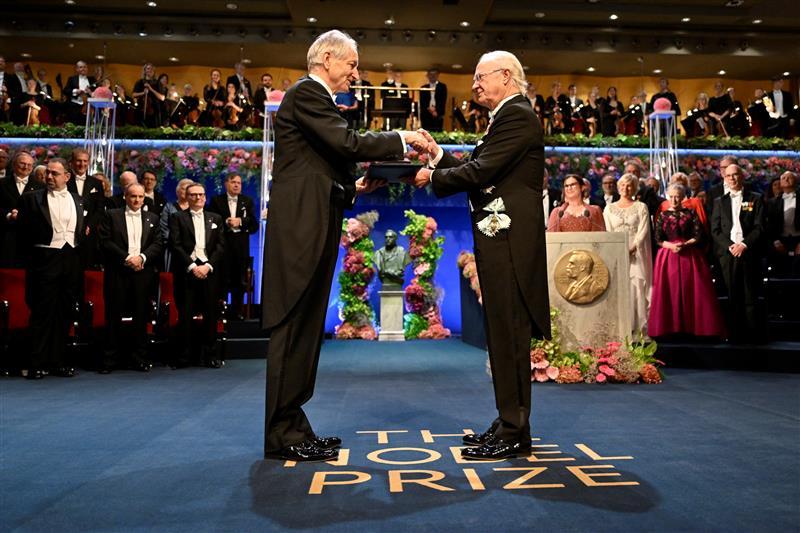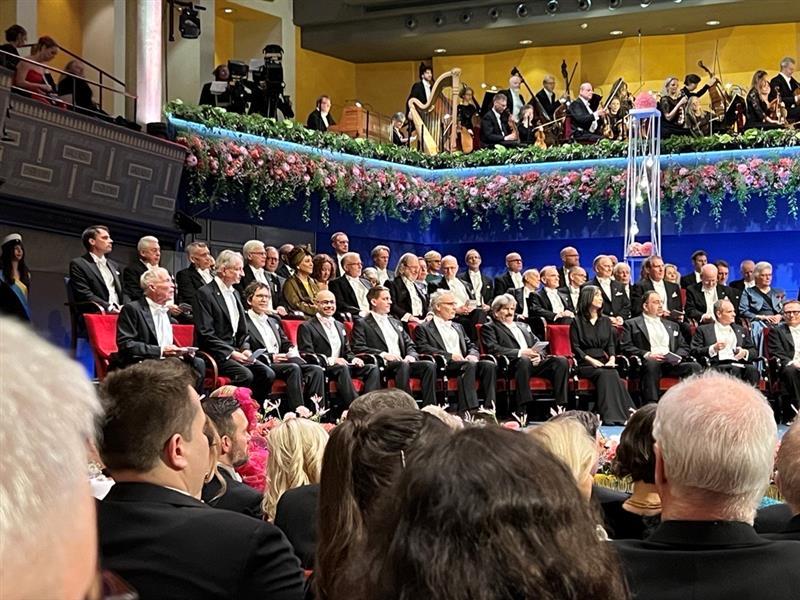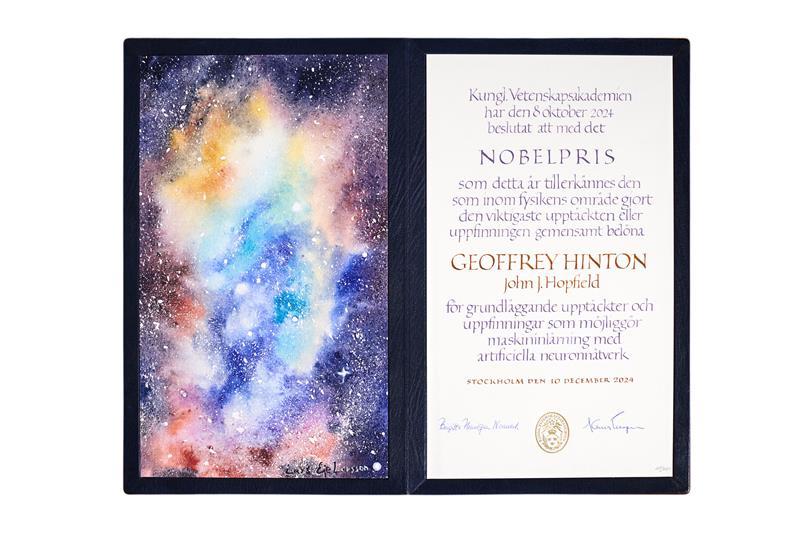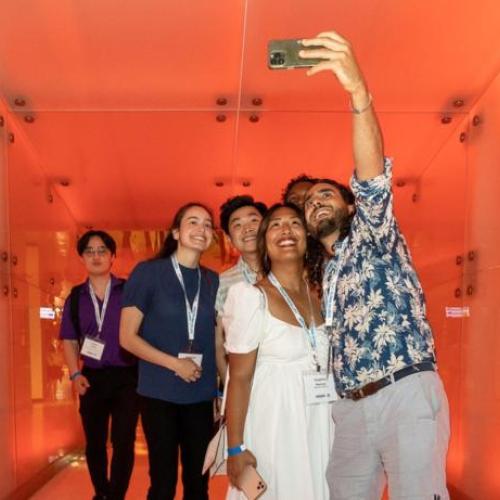December 11, 2024 | Volunteer & Awards
U of T’s Geoffrey Hinton receives Nobel medal, diploma at Stockholm ceremony
“I think we all feel an enormous amount of pride in the fact that [U of T] is one of the places where modern machine learning was really born – in large part due to Geoff Hinton”
By Rahul Kalvapalle

U of T University Professor Emeritus Geoffrey Hinton receives his Nobel Prize in Physics from King Carl XVI Gustaf of Sweden during the Nobel Prize award ceremony in Stockholm. Photo by Henrik Montgomery/TT News Agency/AFP/Getty Images.
The University of Toronto’s Geoffrey Hinton officially accepted his Nobel Prize in Physics during a formal ceremony at Stockholm Concert Hall that included orchestra music, an opera singer and a stage lined with bouquets of flowers.
Wearing white tie and tails, Hinton strode across the dark blue stage emblazoned with the words “The Nobel Prize” to receive his Nobel medal and diploma from King Carl XVI Gustaf of Sweden. Then, as the Royal Stockholm Philharmonic Orchestra sounded a few triumphant notes, he bowed to the Swedish royal family, the audience and returned to his seat at the side of the stage.

And just like that, decades of scholarly endeavour in artificial intelligence (AI) – which began on the fringe of the AI research community and is now poised to forever change modern life – culminated in the U of T University Professor emeritus of computer science known as the “godfather of AI” receiving humanity’s most prestigious award for scientific achievement.
Hinton shared the 2024 Nobel Prize in Physics with John J. Hopfield of Princeton University, who made a similar journey inside the concert hall a few moments earlier. The pair were awarded the prize for discoveries and inventions that enabled machine learning with artificial neural networks, laying the groundwork for today’s AI boom.
“[Geoffrey Hinton] pioneered the efforts to establish deep and dense neural networks,” said Ellen Moons, the chair of the Nobel physics committee, during her introductory remarks. “Such networks are effective in sorting and interpreting large amounts of data and self-improve based on the accuracy of the result.
“Today, artificial neural networks are powerful tools in research fields spanning physics, chemistry and medicine, as well as in daily life.”
In fact, the three winners of the 2024 Nobel Prize in Chemistry – who were seated to Hinton’s left – drew heavily on AI for their work in predicting protein structures and computational design of proteins.

Back in Toronto, members of the U of T community gathered at watch parties on all three campuses to take in the livestream of the awards ceremony – a historic moment for the university.
On the St. George campus, more than one hundred gathered to watch and cheer in the main lobby of the Schwartz Reisman Innovation Campus – home to U of T’s Schwartz Reisman Institute for Technology and Society and the Vector Institute for Artificial Intelligence, where Hinton serves as an advisory board member and chief scientific adviser, respectively.
Among the gathered audience was Michael Guerzhoy, an assistant professor, teaching stream, of engineering science and mechanical and industrial engineering in the Faculty of Applied Science & Engineering who took Hinton’s course on neural networks and machine learning in 2005 – before going on to teach the same course himself several years later.
“I think we all feel an enormous amount of pride in the fact that this is one of the places where modern machine learning was really born, in large part due to Geoff Hinton,” Guerzhoy said. “I think a lot of us owe a personal debt of gratitude to him.”

Fourth-year undergraduate student James Wang said he was “in awe” as he watched Hinton receive his Nobel Prize.
“It makes you feel inspired. You want to be like him, you want to attain the highest level of achievement that anybody can achieve – and not just to do it for your sake, but also for the academic community at large,” Wang said.
There were similar expressions of pride and jubilation at U of T Mississauga, where community members congregated to watch the livestream in the atrium of the Communication Culture & Technology Building, and at U of T Scarborough, where a watch party was organized in the Meeting Place.
As per tradition, the awarding of the Nobel Prize medal and diploma took place on Dec. 10, the anniversary of the death of Alfred Nobel who, in his 1885 will, bequeathed his fortune to create the award.

The gold medal for the Nobel Prize in Physics depicts nature in the form of a goddess resembling Isis, her face covered by a veil held up by the Genius of Science. Inscribed are the Latin words, “Inventas vitam iuvat excoluisse per artes,”which are translated to: “It is beneficial to have improved (human) life through discovered arts.”
The Nobel diploma is crafted on handmade paper and bound in a dark blue leather cover.

Later in the evening, Hinton joined his fellow Nobel laureates, their families, friends and dignitaries for a banquet at Stockholm City Hall.
In an interview with Swedish national broadcaster SVT on the sidelines of the event, Hinton said it was “very exciting but also very exhausting” to take part in the day’s Nobel events.
Reflecting on his upbringing and career, Hinton said his school years – raised as an atheist who went to a Christian school – helped prepare him for his early years as a cognitive scientist working in the then-peripheral area of artificial intelligence.
“From a young age, I was surrounded at school, everybody else had a different opinion and I thought they were wrong – that was very useful when I was studying neural nets,” Hinton said.
“For many, many years, there were only a few of us who believed in neural nets. Everybody else said this was a ridiculous thing to study. And it turned out we were right.”
With files from Adam Elliot Segal.

